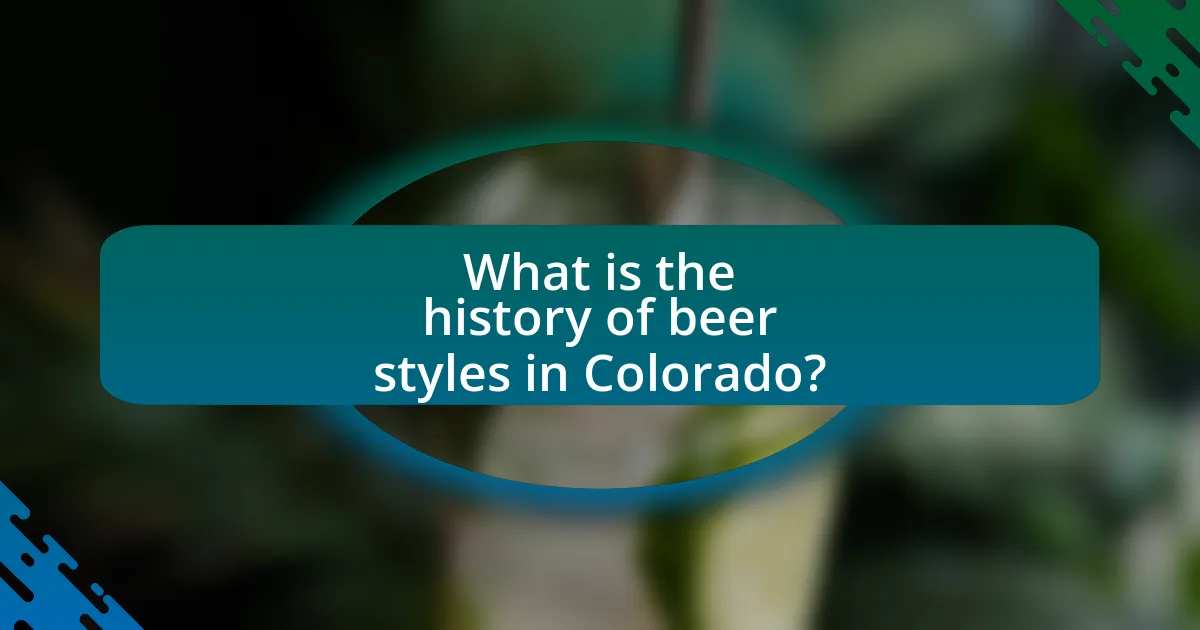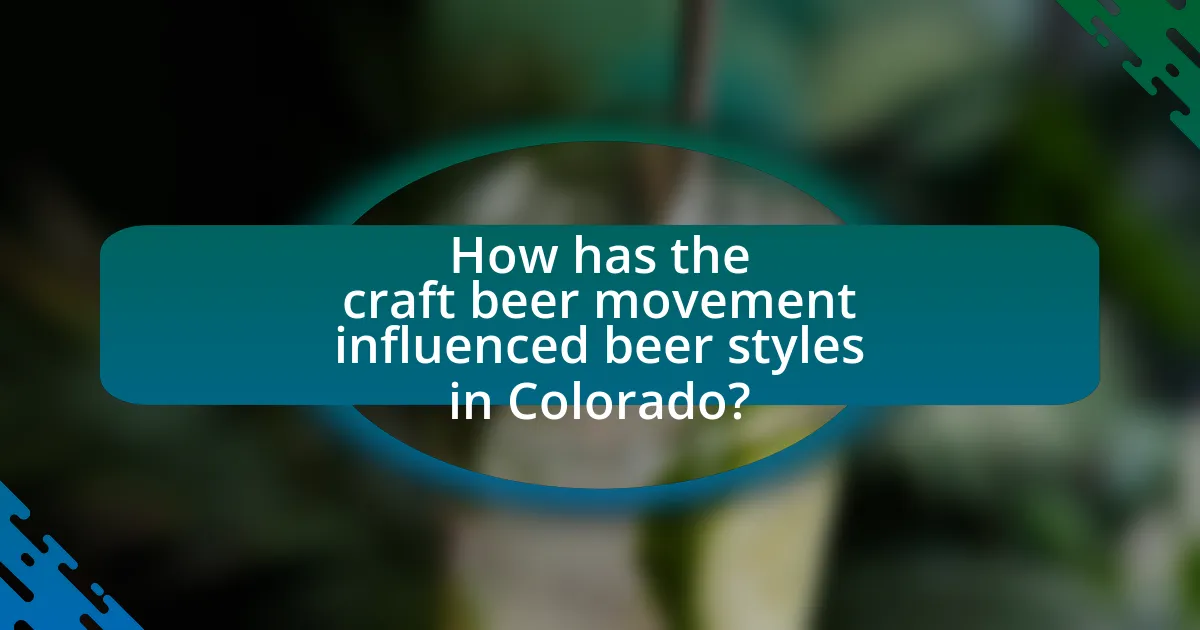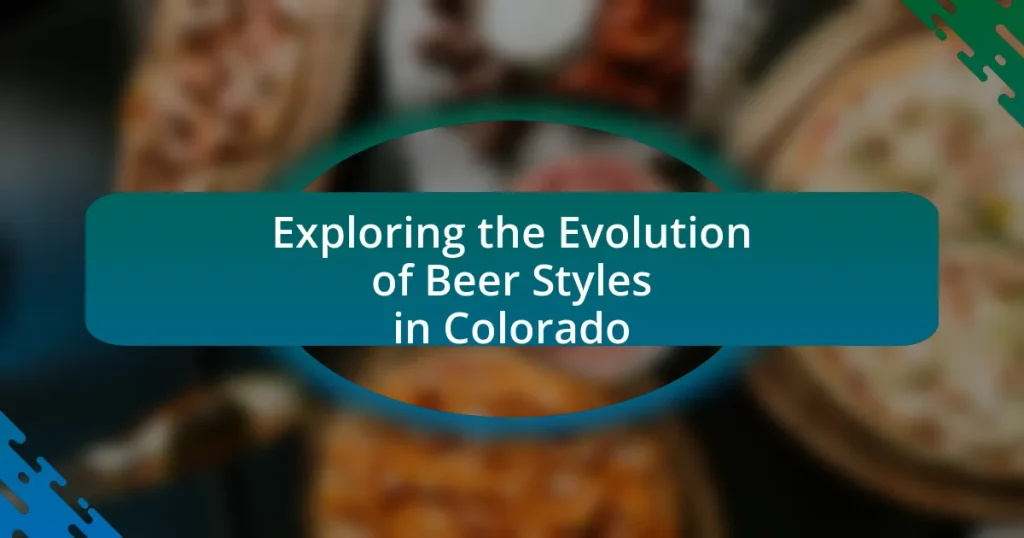The article explores the evolution of beer styles in Colorado, highlighting the state’s rich brewing history that began with German immigrants in the mid-1800s. It details the impact of key events such as the rise of craft brewing in the late 20th century and the legalization of homebrewing, which fostered innovation and diversity in beer styles. The article also examines how local ingredients and immigration have shaped unique Colorado beer styles, including American Pale Ale and Colorado-style Amber Ale, while discussing the challenges and market trends influencing the future of the state’s brewing landscape. Additionally, it provides insights into notable breweries and their contributions to Colorado’s craft beer scene.

What is the history of beer styles in Colorado?
The history of beer styles in Colorado is marked by a diverse evolution influenced by various cultural and environmental factors. Initially, in the mid-1800s, German immigrants introduced lager brewing techniques, establishing a foundation for Colorado’s beer culture. By the late 20th century, the craft beer movement gained momentum, with the establishment of numerous microbreweries and brewpubs, leading to innovative styles such as IPAs, stouts, and sours. As of 2023, Colorado boasts over 400 breweries, making it a significant player in the craft beer industry, with styles reflecting both traditional European influences and unique local adaptations.
How did Colorado’s brewing industry begin?
Colorado’s brewing industry began in the mid-19th century, primarily with the arrival of German immigrants who brought their brewing traditions. These immigrants established the first breweries in the state, such as the Rocky Mountain Brewery in 1859, which catered to the growing population during the Gold Rush. The establishment of these early breweries laid the foundation for Colorado’s rich brewing culture, which has since evolved into a diverse and vibrant industry, recognized nationally for its craft beer.
What were the first beer styles introduced in Colorado?
The first beer styles introduced in Colorado were primarily German lagers and ales. These styles were brought by German immigrants in the mid-19th century, particularly during the Gold Rush era. The establishment of breweries like the Tivoli Brewing Company in 1859 in Denver marked the beginning of a brewing tradition that focused on these European styles, which laid the foundation for Colorado’s diverse beer culture.
How did immigration influence beer styles in Colorado?
Immigration significantly influenced beer styles in Colorado by introducing diverse brewing traditions and techniques. German immigrants, who settled in Colorado during the 19th century, brought with them lager brewing methods, which became foundational to the state’s beer culture. Additionally, Czech immigrants contributed to the popularity of Pilsner-style beers, further diversifying the local beer landscape. The establishment of breweries by these immigrant communities, such as the Coors Brewery founded by German immigrant Adolph Coors in 1873, exemplifies how immigration shaped the brewing industry in Colorado. This blend of cultural influences has led to a rich variety of beer styles that reflect the state’s multicultural heritage.
What key events shaped the evolution of beer styles in Colorado?
The key events that shaped the evolution of beer styles in Colorado include the establishment of the first commercial brewery in 1859, the rise of craft brewing in the 1980s, and the legalization of homebrewing in 1979. The first commercial brewery, the Rocky Mountain Brewery, marked the beginning of Colorado’s brewing history, while the craft beer movement, initiated by breweries like Wynkoop Brewing Company in 1988, significantly diversified beer styles. Additionally, the legalization of homebrewing allowed enthusiasts to experiment and innovate, further contributing to the state’s rich beer culture. These events collectively transformed Colorado into a prominent hub for diverse and unique beer styles.
How did Prohibition impact Colorado’s brewing landscape?
Prohibition significantly disrupted Colorado’s brewing landscape by forcing breweries to close or pivot to alternative products. Between 1920 and 1933, the 18th Amendment prohibited the production and sale of alcoholic beverages, leading to the shutdown of many established breweries, such as the Coors Brewery, which had to adapt by producing non-alcoholic products like malted milk. This period saw a drastic reduction in the number of breweries in Colorado, from over 100 before Prohibition to just a handful by the end of it. The impact of Prohibition not only diminished the brewing industry but also altered the beer culture in Colorado, delaying the resurgence of craft brewing until the late 20th century.
What role did craft breweries play in the revival of beer styles?
Craft breweries played a pivotal role in the revival of beer styles by reintroducing traditional and innovative brewing techniques that had largely been forgotten. They focused on quality, diversity, and local ingredients, which led to a resurgence of interest in styles such as IPAs, stouts, and sours. For instance, the American craft beer movement, which began in the late 20th century, saw a significant increase in the number of breweries, growing from around 8 in 1980 to over 8,000 by 2019, according to the Brewers Association. This growth facilitated experimentation and the revival of historical styles, allowing consumers to explore a wide range of flavors and brewing traditions.

What are the major beer styles that originated in Colorado?
The major beer styles that originated in Colorado include the American Pale Ale, Colorado-style Amber Ale, and the Belgian-style Witbier. American Pale Ale, characterized by its balanced malt and hop profile, gained popularity in the 1980s with breweries like Boulder Beer Company leading the way. Colorado-style Amber Ale features a rich malt backbone and a moderate hop presence, often reflecting the state’s brewing heritage. Belgian-style Witbier, known for its cloudy appearance and citrusy flavors, was popularized by breweries such as New Belgium Brewing. These styles showcase Colorado’s diverse brewing landscape and innovation within the craft beer movement.
What unique characteristics define Colorado beer styles?
Colorado beer styles are uniquely characterized by their emphasis on local ingredients, innovative brewing techniques, and a strong focus on craftmanship. The state’s diverse climate and geography allow for a wide variety of flavors, with many breweries utilizing locally sourced grains, hops, and even water from the Rocky Mountains. Additionally, Colorado’s craft beer scene is known for its experimental approach, often blending traditional styles with new flavors, such as fruit-infused ales and barrel-aged stouts. This creativity is supported by a robust community of craft brewers, with Colorado ranking among the top states in the U.S. for the number of craft breweries per capita, fostering a culture of collaboration and innovation.
How do Colorado IPAs differ from those in other regions?
Colorado IPAs are characterized by a distinct emphasis on hop varieties that thrive in the state’s unique climate, resulting in a more pronounced citrus and pine flavor profile compared to IPAs from other regions. The elevation and water quality in Colorado contribute to the crispness and clarity of these beers, often leading to a more balanced bitterness. Additionally, many Colorado breweries experiment with local ingredients and innovative brewing techniques, which can introduce unique flavor nuances not commonly found in IPAs from other areas. This regional focus on quality and experimentation sets Colorado IPAs apart in the broader craft beer landscape.
What traditional styles have been adapted in Colorado breweries?
Colorado breweries have adapted several traditional beer styles, including German lagers, Belgian ales, and English IPAs. These adaptations often incorporate local ingredients and innovative brewing techniques, resulting in unique interpretations of classic styles. For instance, many Colorado breweries produce variations of Hefeweizen that utilize Colorado-grown wheat, enhancing the flavor profile while maintaining the traditional characteristics of the style. Additionally, the state’s craft beer scene has seen a rise in hybrid styles, such as the Colorado-style pale ale, which blends elements of both American and English pale ales, showcasing the region’s brewing creativity.
What are some notable breweries and their signature styles?
Notable breweries in Colorado include New Belgium Brewing Company, known for its Fat Tire Amber Ale, which exemplifies the American Amber Ale style with a balanced malt profile and a hint of hops. Another significant brewery is Odell Brewing Company, recognized for its IPA, which showcases a blend of citrus and pine flavors characteristic of the American IPA style. Additionally, Avery Brewing Company is notable for its Maharaja Imperial IPA, which features a robust hop character and higher alcohol content, typical of the Imperial IPA style. These breweries have contributed to the diverse beer landscape in Colorado, each offering unique interpretations of established styles.
Which breweries are known for pioneering specific beer styles?
New Belgium Brewing Company is known for pioneering the American-style Fat Tire Amber Ale, which helped popularize the craft beer movement in the United States. Founded in 1991 in Fort Collins, Colorado, New Belgium’s Fat Tire became a flagship beer that introduced many drinkers to craft beer. Additionally, Avery Brewing Company, also based in Colorado, is recognized for its innovative approach to brewing, particularly with its IPA styles, such as the Maharaja Imperial IPA, which has received numerous awards and contributed to the rise of hop-forward beers in the craft beer scene. These breweries have played significant roles in shaping the beer landscape in Colorado and beyond.
How have local ingredients influenced beer styles in Colorado?
Local ingredients have significantly influenced beer styles in Colorado by enhancing flavor profiles and promoting unique regional characteristics. The use of locally sourced grains, hops, and water has led to the development of distinct beer styles such as Colorado IPAs, which often feature floral and citrus notes from native hop varieties. Additionally, the state’s diverse agricultural landscape allows for the incorporation of local fruits and spices, resulting in innovative brews like peach ales and chili-infused stouts. This emphasis on local sourcing not only supports the state’s economy but also fosters a sense of community among brewers and consumers, as evidenced by the rise of craft breweries that prioritize regional ingredients.

How has the craft beer movement influenced beer styles in Colorado?
The craft beer movement has significantly influenced beer styles in Colorado by fostering innovation and diversity among local breweries. This movement has led to the emergence of unique styles such as Colorado IPAs, which are characterized by their bold hop flavors and aromas, and the proliferation of barrel-aged beers that utilize local ingredients. According to the Colorado Brewers Guild, the state has over 400 breweries, many of which experiment with traditional styles, resulting in a rich tapestry of flavors that reflect both local culture and the craft ethos. This emphasis on creativity and quality has positioned Colorado as a leader in the craft beer scene, attracting both enthusiasts and tourists alike.
What trends have emerged in Colorado’s craft beer scene?
Colorado’s craft beer scene has seen a significant trend towards innovative and diverse beer styles, particularly with the rise of hazy IPAs, sour ales, and barrel-aged beers. The state’s breweries have increasingly embraced experimentation, leading to a proliferation of unique flavor profiles and brewing techniques. For instance, the Brewers Association reported that in 2022, hazy IPAs accounted for over 20% of the IPA market share in Colorado, reflecting consumer preference for juicy and aromatic beers. Additionally, the popularity of sour ales has surged, with many breweries incorporating local fruits and wild yeast strains, showcasing Colorado’s agricultural bounty. This trend towards creativity and local sourcing has positioned Colorado as a leader in the craft beer movement, attracting both local and national attention.
How have experimental brewing techniques shaped new styles?
Experimental brewing techniques have significantly shaped new beer styles by introducing innovative ingredients and methods that challenge traditional brewing norms. For instance, the use of unconventional grains, such as quinoa or rice, has led to the creation of gluten-free beers, expanding the market for those with dietary restrictions. Additionally, techniques like barrel-aging and dry-hopping have resulted in unique flavor profiles, exemplified by the rise of sour ales and IPAs that emphasize hop character. The Colorado craft beer scene, known for its creativity, has seen breweries like Crooked Stave and Avery Brewing utilize wild yeast strains and fruit additions, further diversifying the styles available. This experimentation not only enhances flavor complexity but also fosters a culture of innovation, encouraging brewers to push boundaries and explore new possibilities in beer production.
What role do beer festivals play in promoting Colorado beer styles?
Beer festivals play a crucial role in promoting Colorado beer styles by providing a platform for local breweries to showcase their unique offerings. These events facilitate direct interaction between brewers and consumers, allowing attendees to sample a diverse range of Colorado-specific beer styles, such as IPAs, stouts, and sours. According to the Colorado Brewers Guild, beer festivals contribute significantly to the state’s craft beer culture, with events like the Great American Beer Festival attracting thousands of visitors and highlighting the innovation and quality of Colorado’s breweries. This exposure not only boosts local sales but also enhances the reputation of Colorado as a premier craft beer destination.
What challenges do Colorado breweries face in evolving beer styles?
Colorado breweries face challenges in evolving beer styles primarily due to market saturation and consumer preferences. The craft beer market in Colorado has grown significantly, with over 400 breweries as of 2023, leading to intense competition. This saturation makes it difficult for breweries to differentiate their products and innovate without risking consumer alienation. Additionally, changing consumer tastes, influenced by trends towards lighter and more sessionable beers, require breweries to adapt their offerings continually. According to the Brewers Association, 60% of craft beer drinkers prefer IPAs, which pressures breweries to focus on popular styles rather than experimental ones. These factors create a complex environment for Colorado breweries striving to evolve while maintaining their unique identities.
How do regulations impact the development of new beer styles?
Regulations significantly impact the development of new beer styles by dictating the ingredients, production processes, and labeling requirements that brewers must follow. For instance, in Colorado, the Colorado Liquor Code regulates the types of ingredients that can be used in brewing, which can limit creativity and innovation in developing unique beer styles. Additionally, regulations regarding alcohol content and health standards can influence the brewing techniques and flavor profiles that brewers pursue. Historical data shows that states with more flexible regulations tend to have a higher diversity of beer styles, as seen in Colorado’s craft beer scene, which has flourished under relatively supportive regulatory frameworks.
What market trends are influencing the future of Colorado beer styles?
The market trends influencing the future of Colorado beer styles include a growing demand for craft and local beers, an emphasis on sustainability, and the rise of innovative flavors and styles. The craft beer segment in Colorado has seen significant growth, with over 400 breweries as of 2023, reflecting consumer preference for locally sourced products. Additionally, sustainability practices, such as using organic ingredients and eco-friendly packaging, are becoming increasingly important to consumers, driving breweries to adopt these methods. Furthermore, experimentation with unique ingredients and brewing techniques, such as barrel-aging and souring, is shaping new beer styles, catering to adventurous palates and enhancing the diversity of offerings in the Colorado beer market.
What are some tips for exploring Colorado’s diverse beer styles?
To explore Colorado’s diverse beer styles, start by visiting local breweries, as Colorado is home to over 400 breweries, offering a wide range of styles from IPAs to stouts. Engage in brewery tours and tastings to gain insights into the brewing process and the unique ingredients used. Attend beer festivals, such as the Great American Beer Festival, which showcases a variety of Colorado beers and allows for sampling different styles. Additionally, consider joining a beer tasting group or club to learn from fellow enthusiasts and expand your palate. Exploring beer styles can also be enhanced by pairing them with local cuisine, as many breweries offer food menus that complement their brews.


